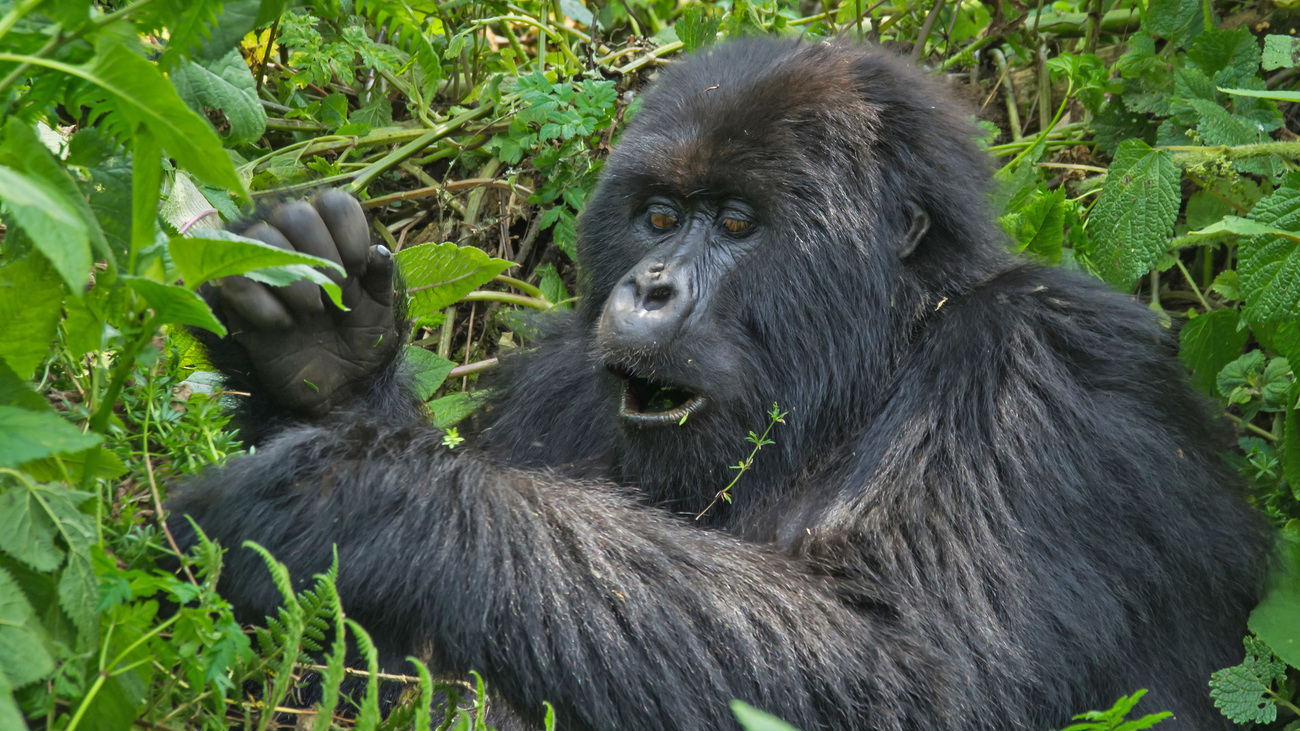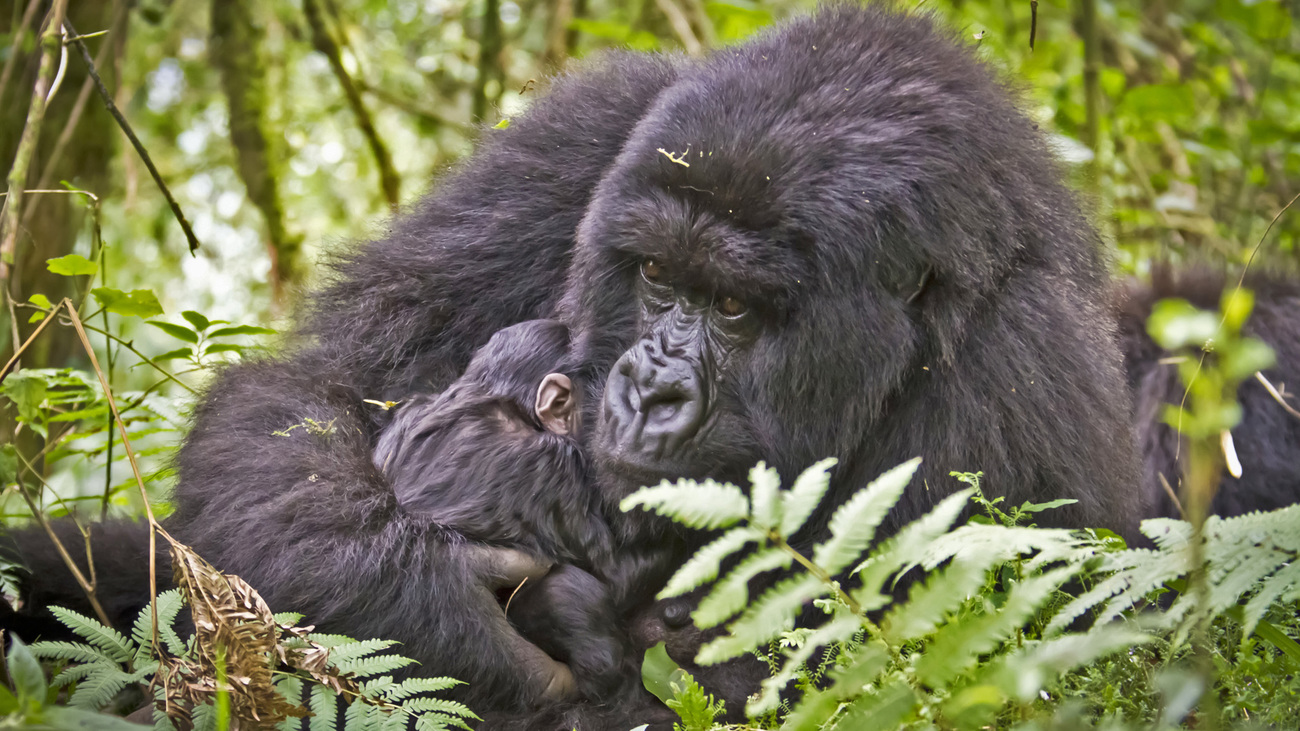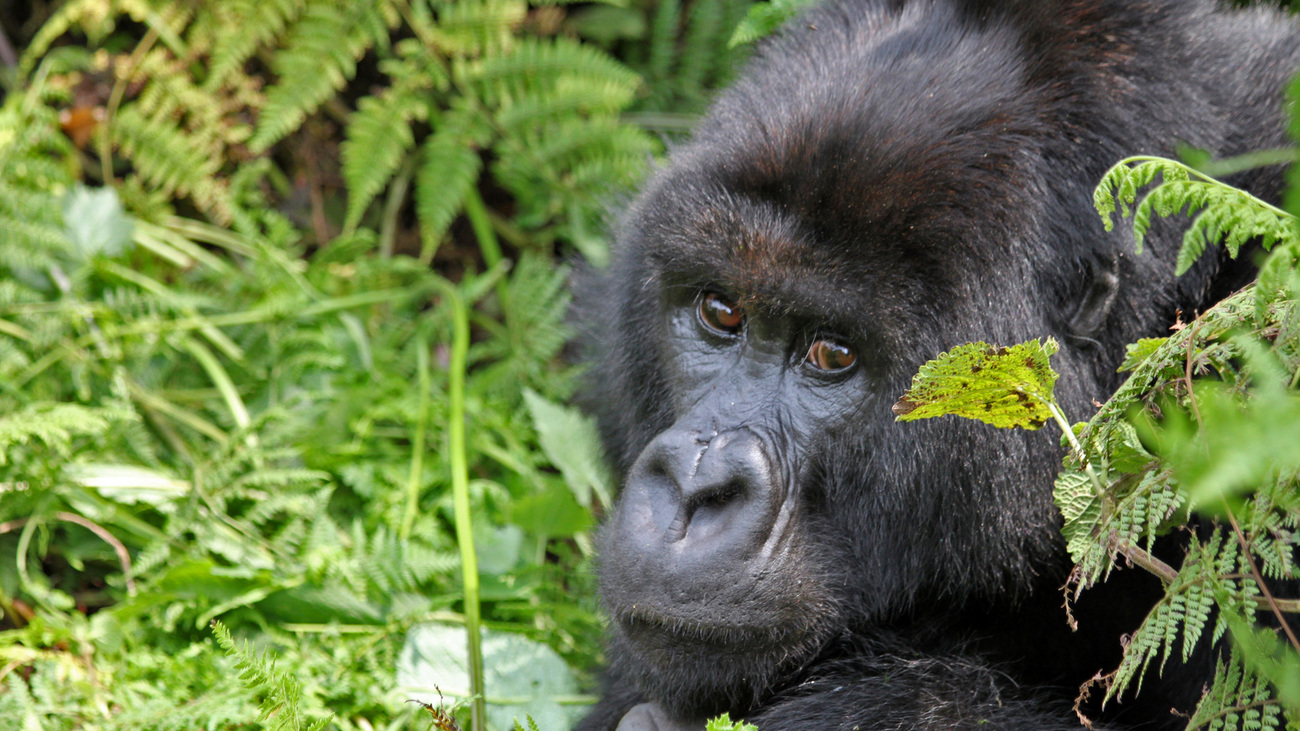Mountain gorillas
Mountain gorillas are one of the largest and strongest living primates. However, these social, peaceful, and mostly vegetarian creatures are gentle giants. As researchers studying mountain gorillas in the wild have found, the teeth-baring, chest-pounding displays we often associate with great apes are not representative of their true nature.
Mountain gorillas exhibit many human-like emotions and behaviours, such as sadness, playfulness, grief, and laughter. They share 98.3% of their genetic code with humans, making mountain gorillas our closest relatives in the animal kingdom after chimpanzees and bonobos.
Mountain gorillas live in groups or troops of around 10 to 30, led by a dominant male gorilla—or silverback—who holds his position for many years. While he may sometimes resort to charging and chest pounding, this behaviour is usually intended to intimidate rivals or warn off any perceived threats to the group. The alpha male leader is called a silverback because a section of the black hair on a male’s back begins to turn from black to grey when he reaches around 12 years of age. Alongside the silverback male, other members of a typical mountain gorilla group include several younger males—called blackbacks—as well as adult females, juvenile females, and infants.
Although mountain gorillas can climb trees, they are usually found on the ground living in high-altitude bamboo forests. To stay warm in the mountains, these great apes have longer, thicker hair than other kinds of gorillas and tend to be stockier with shorter arms.
Mountain gorillas are classified as omnivores but eat a mainly plant-based diet, spending large portions of their days feeding on bamboo shoots, leaves, stems, and, occasionally, fruit. They supplement this with bark, rotting wood, and invertebrates.
Through their diet and behaviour, mountain gorillas play a vital role in maintaining the biodiversity of their habitats. When eating fruits and other plant matter, they spread seeds around, assisting in the growth of new plants and trees. Eating rotting bark from trees helps speed up the cycle of plant regrowth, while any bark or wood they discard can also serve as a damp shelter and source of nutrients for many smaller animals and plants. And, by opening up gaps in the trees as they move through their forest homes, they let in light and help plants photosynthesise and grow.
What is a mountain gorilla’s scientific name?
The scientific name for the mountain gorilla is Gorilla beringei beringei. This translates from Latin as ‘gorilla of Kivu highlands’.
Are mountain gorillas endangered?
Yes, mountain gorillas are classified as endangered by the International Union of the Conservation of Nature (IUCN). However, they were previously classified as critically endangered until as recently as 2018. Thanks to conservation efforts by organisations such as IFAW and various government interventions, the world mountain gorilla population finally started to increase after many years in decline. At present, they are the only great ape with an increasing population.
Where do mountain gorillas live?
As their name suggests, mountain gorillas live in forest-covered mountainous zones, usually between 2,400 and 4,000 metres (8,000 and 13,000 feet) of elevation.
All mountain gorillas living in the wild are limited to two isolated areas across three countries in East-Central Africa. One of these mountain gorilla habitats is on the borders of Rwanda, Uganda, and the Democratic Republic of the Congo (DRC) and includes three national parks—Mgahinga Gorilla National Park, Volcanoes National Park, and Virunga National Park. The other mountain gorilla population lives in Bwindi Impenetrable National Park in Uganda, which connects to the Sarambwe Nature Reserve in DRC.
Within their established mountain gorilla habitat, these primates move around a range of up to 39 square kilometres (15 square miles). At night, mountain gorillas sleep together in nests made from foliage. Some of the younger, more lightweight mountain gorillas nest in trees by making beds of bent branches. Heavier group members nest in grasses on the ground and infant mountain gorillas will share their mother’s nest to stay safe and warm.
Threats
These large, strong apes have very few natural predators. Yet, due to detrimental human activity, such as hunting, habitat destruction, human conflict, and human encroachment, mountain gorillas face many threats to their ongoing survival.

Hunting and trade
The commercial bushmeat trade that continues throughout West and Central Africa poses a major threat to mountain gorillas. While mountain gorillas only represent a small portion of all animals killed for meat, their already low population is easily endangered by even low levels of hunting.
Although it is illegal to hunt gorillas or trade in gorilla products, weak law enforcement practices and wider government failings mean that poachers, traders, and consumers rarely face punishment.
In some places, the wealthy elite considers the consumption of ape meat prestigious, driving the demand for such meat in urban centres. For hunters, mountain gorillas are an easy target and provide a large quantity of valuable meat per kill.
Habitat loss
An even greater threat to mountain gorillas is the destruction of their habitat. As the region’s human population grows, more and more land is needed for agriculture. Deforestation caused by this as well as the expanding mining and logging industries forces mountain gorillas and humans to share scarce resources within an increasingly limited area.
With little other choice, humans must enter mountain gorilla forests to collect firewood and water. Likewise, mountain gorillas venture onto the farmland that borders their shrinking forest habitats to eat crops such as bananas and maize. This then increases the mountain gorillas’ chance of encountering humans and contracting illnesses.

Human conflict
Mountain gorillas living in the forests of the Democratic Republic of Congo (DRC) and across the border in Rwanda must also contend with another threat to their lives in the form of human conflict.
DRC has experienced political instability and pressure from rebel groups since it achieved independence from Belgium in 1960, with war raging in and around the region since the 1990s. Many mountain gorillas have been caught directly in the crossfires of this ongoing war as well as facing indirect harm due to the degradation of their habitat.
Human encroachment
Humans don’t have to physically harm mountain gorillas to pose a threat to their lives. As people move closer to the home environment of these great apes, they bring the risk of human diseases.
Since we share over 98% of our DNA with mountain gorillas, they are susceptible to human illnesses. But, without having developed the necessary immunities to battle them off, even a simple cold could prove deadly to these great apes. Populations of mountain gorillas that often come into contact with humans are especially vulnerable to respiratory infections, while the gorillas who raid farms are at risk of scabies and tuberculosis.
One of the most harmful human diseases threatening the mountain gorilla population is Ebola hemorrhagic fever, a severe and often fatal infectious disease. One study even found that within a single area, Ebola wiped out around 5,000 gorillas between 2002 and 2003. Although these were not all mountain gorillas, Ebola remains a huge threat to their already precarious numbers.
FAQs
What do mountain gorillas eat?
Mountain gorillas are omnivores, meaning that they eat a combination of plant-based and animal-based foods. That said, around 85% of the mountain gorilla diet is made up of leaves, shoots, stems, and other plant matter. Mountain gorillas also eat snails, ants, worms, and larvae for protein and extra calories.
They are often observed eating and licking tree stumps, rotting wood, and bark, which scientists determined to be for the dietary sodium these materials provide. To fuel their metabolism and sustain their massive bulk, mountain gorillas spend at least a quarter of their time eating and can consume up to 34 kilograms (75 pounds) of vegetation each day.
How many mountain gorillas are left in the world?
The IUCN states that there are around 600 mature mountain gorillas left in the world.
How much does a mountain gorilla weigh?
Silverback gorillas can weigh up to 180 kilograms (397 pounds). Non-dominant adult males usually weigh around 120 to 150 kilograms (265 to 330 pounds), while female gorillas weigh around 90 kilograms (198 pounds).
Baby gorillas are tiny in comparison to their powerful parents. At birth, they weigh only 1.8 kilograms (four pounds).
How big are mountain gorillas?
On average, a silverback gorilla can measure up to 170 centimetres (around five feet and seven inches) tall when on all fours. Blackbacks tend to be a little shorter than this, while female mountain gorillas measure up to 150 centimetres (four feet and 11 inches).
Why are mountain gorillas endangered?
Mountain gorillas are endangered because of the various threats that humans pose to their existence, including hunting, habitat destruction, human conflict, and human encroachment.
Mountain gorillas are an easy and desirable target for hunters looking to sell their meat to wealthy consumers. While mountain gorillas live in areas marred by human conflict and are often caught in the crossfire, their natural habitat is fertile and rich in biodiversity, making it ideal for human populations to use for homes and resources. Human contact is also dangerous for mountain gorillas as they are susceptible to human diseases but don’t have the necessary immunities to fight them off.
All these threats to their population might not be as detrimental if it weren’t for mountain gorillas’ low reproductive rates. Like humans, mountain gorillas reproduce slowly. Female gorillas start breeding when they are around 10 years old but give birth to just one infant at a time after a pregnancy of almost nine months. They then spend several years raising that infant before giving birth again. This means that mountain gorillas are vulnerable to even slight population declines, which can then take several generations to overcome.

How long do mountain gorillas live?
In the wild, mountain gorillas can live to over 40 years old, although on average they live for around 35 years. Mountain gorillas are classed as infants until they are around 4 years old and then become adults when they reach 8 years.
What is special about a mountain gorilla’s nose?
All mountain gorillas have wrinkles above their nostrils that are as unique to them as fingerprints are to humans.
When scientists first began observing mountain gorillas in the 1950s, they needed a method of identification for record keeping. After noticing that every mountain gorilla nose featured a unique wrinkle pattern, Schaller, Fossey, and other gorilla researchers began using noseprint identification to create databases for long-term population monitoring.
Combining photos and drawings of mountain gorilla noses as well as observations of other physical characteristics, researchers have been able to identify individual mountain gorillas and follow their behavioural patterns, dietary habits, and more.
Are mountain gorillas different from gorillas?
Yes, mountain gorillas are different from gorillas (Gorilla gorilla) in several ways.
The genus Gorilla is divided into two species—the eastern gorilla and the western gorilla—and then a further four subspecies. Mountain gorillas are one of the two subspecies of eastern gorillas. The other is the eastern lowland gorilla (Gorilla beringei graueri). In total, there are around 5,000 eastern gorillas left in the world.
In comparison, there are 316,000 western gorillas in the world. Since the population of western gorillas is far greater, most people think of these when they hear the name gorilla. The two western gorilla subspecies are the western lowland gorilla (Gorilla gorilla gorilla) and the Cross River gorilla (Gorilla gorilla diehli).
Compared to other gorillas, mountain gorillas have shaggier fur, shorter arms, and smaller yet bulkier frames. Their faces are also flatter and furrier, and their eyes are deeper-set.
Aside from their different genus classification and appearance, mountain and lowland gorillas have different habitats. Mountain gorillas live in high altitudes, whereas lowland gorillas live in tropical forests. Mountain gorillas also live in larger groups than their western cousins, and their diet is also slightly different. While mountain gorillas eat mostly plant materials, western gorillas supplement their plant intake with more insects, fruits, and small reptiles.

How are mountain gorillas affected by climate change?
Mountain gorillas live in cool, high-altitude areas. As climate change drives average global temperatures up, gorillas have to move to higher elevations. While gorillas are adaptive, these already small areas are densely-populated and rarely have enough forest left to provide mountain gorillas with the food and shelter on which they rely to survive.
How can you help?
Mountain gorillas are endangered, with hunting and trade, habitat loss, and human conflict and encroachment threatening the remaining populations.